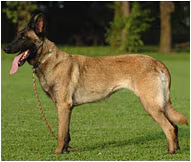About
They give the impression of elegant robustness. A hardy dog, accustomed to living outdoors with a coat built to resist the damp Belgian climate. Their elegance and expression denote great strength of character, making them a proud representative of the herding breeds. The Belgian Malinois is an enthusiastic and quick dog with a natural tendency to be in motion. Males are 24 to 26 inches tall and weigh 55 to 75 pounds (25 to 34 kilograms). Females are 22 to 24 inches and weigh 40 to 60 pounds (18 to 27 kilograms).The coat should be comparatively short and straight, hard enough to be weather resistant, with a dense undercoat. It should be very short on the head, ears and lower legs. The hair is somewhat longer around the neck where it forms a collarette, and on the tail and backs of the thighs. The coat should conform to the body without standing out or hanging down.The basic colouring is a rich fawn to mahogany, with black tips on the hairs giving an overlay appearance. The mask and ears are black. The Belgian Malinois is a double-coated breed and will generally shed twice a year. Bathing when dirty, brushing once or twice a week, and clipping the nails will keep your Malinois in great condition.|
Personality
The Belgian Malinois excels not only in herding, but also in protection and law enforcement; drug, bomb, and gas detection; search and rescue; tracking; obedience; sledding; agility; and therapy assistance to disabled, ill or elderly people. This dog is demanding and needs an experienced owner. A wide range is seen in temperament and aggressiveness. They want nothing more than to be with their family, which makes them unsuitable as a kennel dog.
What to Expect
The Belgian Malinois is a very smart and obedient dog. They have strong protective and territorial instincts. This breed needs extensive socialisation from an early age, and firm, but not harsh, training. Belgians are instinctively protective, so they should be trained and socialised very well from an early age. Unless you are specifically working in a protection sport, you do not need to give your Belgian any protection training, as it will come naturally to them. Belgians make excellent pets for the right homes, as they thrive on loving companionship. Malinois instinctively display herding behaviour such as chasing and circling, moving effortlessly for hours and nipping at people's heels. They are good for working and competitive obedience, but not for toddlers who run and scream. A Belgian Malinois will constantly be trying to keep the toddler in one spot!The Belgian Malinois can live in a flat if it is sufficiently exercised. Moderately active indoors, they will do best with at least an average-sized garden. They prefer cool climates, but readily adapt well to others. A Belgian Malinois should live to be 12 to 15 years.
History
The Belgian Malinois is one of the varieties of the Belgian shepherd. All are named after Belgian villages: Groenendael, Laekenois, Mechelar (Malinois) and Tervuren.The history of the Belgian Malinois goes back to the 1880s when these dogs (with German shepherds, French shepherds and Dutch shepherds) were called continental shepherd dogs. In 1891, the Belgian Shepherd Dog Club was formed, and a panel of judges determined that there was a congruous type of native shepherd dog that was a square, medium-sized dog with well-set triangular ears. These dogs differed only in the texture, colour and length of hair. In 1892, the first Belgian shepherd dog standard was written recognising three varieties: dogs with long coats, short coats and rough coats.The Belgian Malinois, along with the Groenendael, was the first variety to appear in the United States in the early part of the 1900s. The Belgian Sheepdog Club of America (the Malinois, Groenendael, and Tervuren were all the same breed at that time) was formed and the breed began to show in the American Kennel Club in the early 1950s. In 1959 the Belgians separated into the three AKC breeds recognised today, sheepdog, Tervuren and Malinois.
Adopt a pet. Change a life.
Are you prepared to adopt a pet? Use these tools to make sure you are ready for the commitment.
Adopt a pet. Change a life.
Are you prepared to adopt a pet? Use these tools to make sure you are ready for the commitment.





















